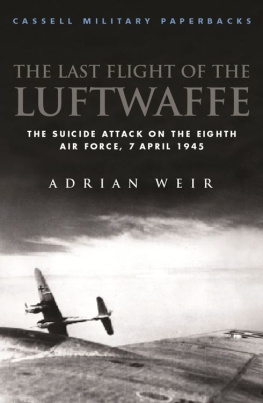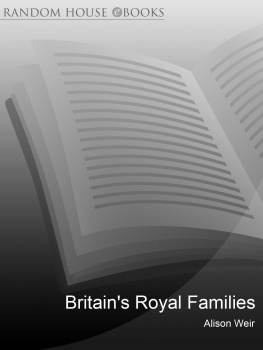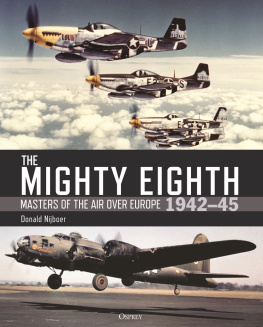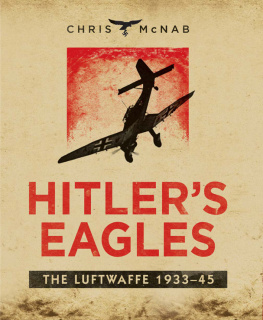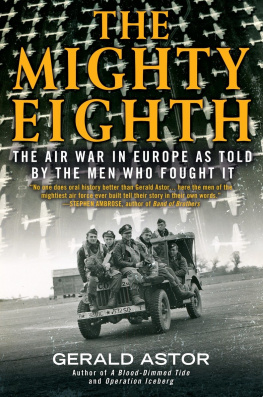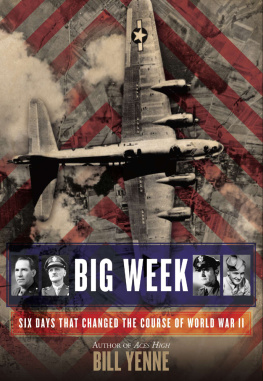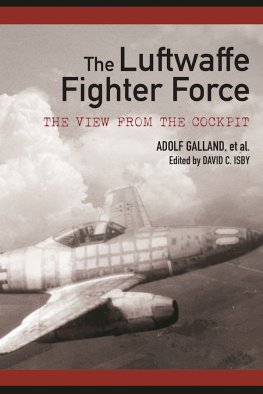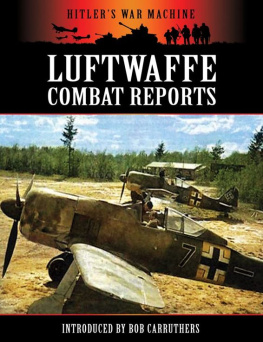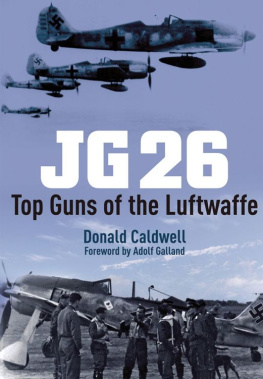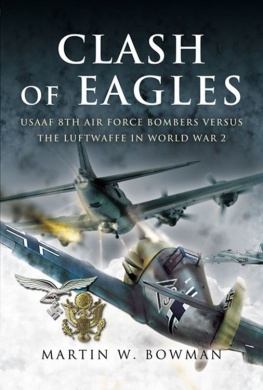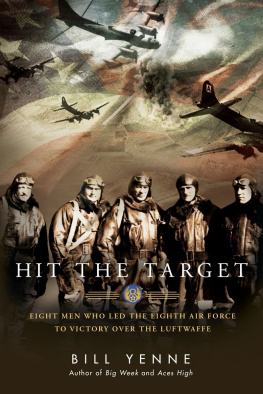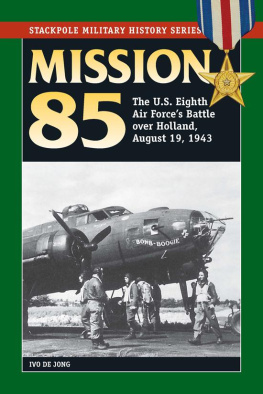THE LAST FLIGHT OF THE
LUFTWAFFE
THE SUICIDE ATTACK ON THE EIGHTH
AIR FORCE, 7 APRIL 1945
ADRIAN WEIR
CASSELL
CONTENTS
PREFACE
The research which led to this book began as a simple attempt to find out more about the events which took place over Germany on 7 April 1945. Many works which examine Luftwaffe activity during the closing stages of the war in Europe give vague details regarding a special operation mounted that day against US Eighth Air Force bombers. All these accounts give enough detail to interest the reader but little more. After more than fifty years, and with so many facts revealed about the 193945 war, surely it would prove a simple task to find a full account of this operation.
In fact it proved to be almost impossible using existing references. As more sources were examined, more conflicting evidence was revealed. How large had this operation been? How had it been formed? Was the unitas had been frequently been suggesteda suicide formation linked somehow to the so-called Selbstopfermnner (literally, self-sacrifice men)? Even the name of the unit was in doubt. Was it Rammkommando Elbe or Lehrgang Elbe, or did it carry the evocative name which has been linked to many late-war operationsWehrwolf? The account which appeared to offer the most help was that in the book written by Herr Hajo Herrmann, the Luftwaffe officer whose name was linked with the planning behind the unit and its operation. However, Herr Herrmann does not dwell in detail upon the battle fought over Germany on 7 April 1945, allocating a mere handful of pages to the subject.
So began a time-consuming and often confusing search for the truth. Through good fortune, two early contacts were to prove the most valuable. The first was the German author Herr Ulrich Saft, who had already spent much of his time researching similar subject matter and had been able to meet with many of those involved. Much of the information relating to the Luftwaffe operations has been confirmed by Herr Saft in his book Das Bittere Ende der Luftwaffe. The detailed investigation carried out by Herr Saft has provided a source of information which would otherwise have been unavailable.
The second contact was to prove even more important. The author was informed by Herr Herrmann that a veterans group had been established for those involved in the Elbe operation and was then pleased to be put in touch with Herr Werner Zell, who was closely linked to the founding and running of this group. By means of a lengthy correspondence with an ever-patient Herr Zell, himself a survivor from 7 April 1945, the author was able to find answers to many of the remaining questions. Without the starting point provided by Herr Safts book and without the kind help offered by Herr Zell, the present work would not have been possible, and the author is indebted to these two gentlemen.
In preparing this work the author also returned to unpublished official records of the Eighth Air Forces operations of 7 April 1945. This has allowed a list of events to be built up using first-hand information, prepared only a matter of hours after the events themselves took place. It has, then, been possible to assemble the framework, as it were, around the picture of the mission flown by the Elbe force. Wherever possible, combats have been described from the point of view of each side, although of course the individual incidents were confused and much detail has proved difficult to confirm. However, in these instances the author has avoided the temptation simply to follow the narratives provided by earlier workseven that by Herr Saft. By examining the reports prepared by bomber crews and staff of the Eighth Air Force and from contacts made with the survivors, it has proved possible to match some of the events and actions. Where the chaotic skirmishes clouded the story some assumptions have been made, but in other cases the reader is provided only with confirmed facts. To many readers the events described in the early chapters will be well known, but it is felt that in order to understand the formation and operation of Elbe such background informationfor example, General Gallands Grosse Schlag and the career of Hajo Herrmannneeds to be re-stated.
A word of thanks must go to all those who have helped in the research for this book, and to one further personthe authors wife Gillian, who supported the project and provided the necessary encouragement for it to be completed.
ACKNOWLEDGEMENTS
The following is a list of all those who provided help, advice or encouragement during the preparation of this book. In Belgium: P. J. Martin. In Germany: Hajo Herrmann; Gunter Herz; Wolfdietrich Hoeveler, Editor, Flug Revue; Rainer Laabs, Ullstein GmbH; Johannes Mohn, Editor, Jgerblatt, Gemeinschaft der Jagdflieger; Generalleutnant Gnther Rail; Lilo Rubberts; Ulrich Saft; Frau Scholl, Bundesarchiv, Freiburg; Hansjurgen von Reigen; Bruno Waltert, Editor, Berliner Morgenpost; Hans-Joachim Wicht, Editor, Altmark-Zeitung, Salzwedel; and Werner Zell. In the United Kingdom: John Armstrong; Colin Durrant, 390th BG Memorial Museum, Ipswich; R J. V. Elliott, The Royal Air Force Museum, Hendon; Jacqui Etheridge, The British Film Institute; Ken Everett, 100th BG Memorial Museum, Diss, Norfolk; Paul Goodman, National Museum of Photography, Film & Television, Bradford; Paul Kemp, Imperial War Museum, London; Rita Klapper, for valuable help in translating seemingly endless streams of material; Ian F. Mason, for his expert knowledge of the Bf 109G, gained from his work on Black 6; Kathy Moran, The Fighter Collection; Alan Parker, Frank Smith Books, Newcastle-upon-Tyne, for always finding the titles I needed; Doris E. Pullen; Richard S. Robinson, for help in finding the needle in the haystack; David Tappin; and H. J. Woodend, Ministry of Defence, Pattern Room, Nottingham. In the USA: Lieutenant-Colonel Richard Asbury; Dr Fred Beck, USAF History Support Center, Bolling AFB, DC; Colonel Ward Boyce, American Fighter Aces Museum, Mesa, Arizona; Jim Carlisle, USAF AFMPC, Randolf AFB, Texas; Robin E. Cookson, US National Archives, Maryland; Timothy J. Cronen, Smithsonian Institution, NASM, Washington, DC; Colonel Louis H. Cummings, USAF Historical Foundation, Andrews AFB, Maryland; Jeffrey L. Ethell; Garry L. Fry, for allowing me access to his records and for his friendly advice; William E. Howard, former 100th BG pilot; James H. Kitchens III, USAF Historical Research Agency, Maxwell AFB, Alabama; Rebecca Lentz Collier, US National Archives, Washington, DC; and Major Joe T. Reams, USAF Historical Research Agency, Maxwell AFB. Finally, special thanks go to Peter Burton and Roderick Dymott of Arms & Armour Press, who both showed surprising confidence in this project, and to Roger Chesneau, for turning my words into this book.
A.W.
INTRODUCTION
Throughout mankinds unending commitment to, and long fascination with, warfare, many actions during the ages have stood as memorials to the ultimate in courage and sacrifice. When examined in retrospect, how such actions are judged depends very much on the side with which ones alliances lie. Deeds of self-sacrifice can be described simultaneously as displaying both courage and stupidityeven a misguided fanaticism.
In the all too numerous conflicts which have touched the lands occupied by man, time and again examples can be found of the few standing fast against the many. In the ancient world, the courage of a small number of Spartan warriors, led by their king Leonidas, in defending the strategic pass of Thermopylae in 480 BC against the greater numerical strength of a Persian army became a symbol of determined resistance. By an act of self-sacrifice these troops provided a valuable breathing space, which facilitated the successful evacuation of Athens, until that moment threatened by the invading Persian forces. By their refusal to yield to superior numbers and by their disciplined resistance, the warriors of Sparta provided the standard against which all future defending forces would be judged.
Next page
